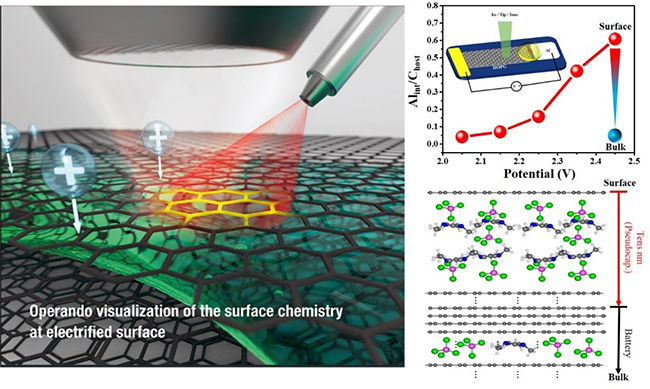Surface and interface play critical roles in energy storage devices, thus calling for in-situ/operando methods to probe the electrified surface/interface.
However, the commonly used in-situ/operando characterization techniques such as X-ray diffraction (XRD), transmission electron microscopy (TEM), X-ray spectroscopy and topography, and nuclear magnetic resonance (NMR) are based on the bulk regions of the electrodes or electrolytes which overlook the critical surface/interface behaviors.
Recently, a research team led by Prof. FU Qiang from the Dalian Institute of Chemical Physics of the Chinese Academy of Sciences (CAS) reported the surface effect on aluminum ion battery (AIB) by operando surface science methodology.
The results were published in Natl. Sci. Rev. on March 21.

Super-dense intercalated anions together with cations in the surface region of graphite electrode have been visualized by operando surface science methodology over an Al/HOPG planar model device (Image by Chao Wang)
Surface science methodology established by Langmuir, Ertl, et al. has proven to be successful in providing a detailed description of how chemical reactions take place on solid surfaces. The applications of the surface science methodology on catalysis research have been made significant progresses but remain less explored and more challenging on electrified surface/interface.
In this work, based on well-designed planar Al/HOPG model battery and corresponding operando characterization cell/stage, multiple operando surface science characterizations including Raman, XPS, AFM and SKPM were performed over the model battery.
Super-dense intercalated anions (AlCl4-) together with cations (EMI+) in the surface region of the graphite electrode were visualized. The observed unusual electrochemical behavior in surface region could be described as the intercalation pseudocapacitor in contrast with the battery process in the bulk. The quantitative description of the electrochemical reactions of AIB and the distinct surface effect of the charge storage electrode were demonstrated by the operando surface science analysis.
Guided by this distinct surface effect, the capacity could be doubled by using surface-dominant nano-thick graphite electrode.
This research suggests a new strategy for operando studies of the surface chemistry over electrified surface/interface and highlights the significance of the surface effect in electrochemical devices.
This work was done in collaboration with Prof. WU Zhongshuai and Prof. LI Xianfeng from DICP and Prof. CHEN Liwei from Suzhou Institute of Nano-Tech and Nano-Bionics of CAS, Prof. GAO Chao from Zhejiang University and Prof. WU Chuan from Beijing Institute of Technology.
This work was supported by the National Natural Science Foundation of China, the National Key R&D Program of China, the Strategic Priority Research Program of the Chinese Academy of Sciences, and the DICP&QIBEBT funding. (Text by WANG Chao)